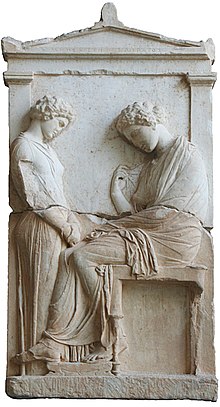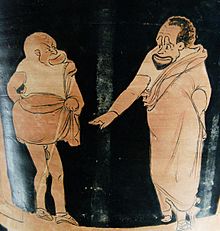Slavery in ancient Greece

Slavery was an accepted practice in ancient Greece, as in other societies of the time. Some Ancient Greek writers (including, most notably, Aristotle) described slavery as natural and even necessary. This paradigm was notably questioned in Socratic dialogues; the Stoics produced the first recorded condemnation of slavery.[2]
The principal use of slaves was in agriculture, but they were also used in stone quarries or mines, and as domestic servants. Athens had the largest slave population, with as many as 80,000 in the 5th and 6th centuries BC, with an average of three or four slaves per household, except in poor families. Slaves were legally prohibited from participating in politics, which was reserved for citizens.
Modern historiographical practice distinguishes between chattel slavery (personal possession, where the slave was regarded as a piece of property as opposed to a mobile member of society) versus land-bonded groups such as the penestae of Thessaly or the Spartan helots, who were more like medieval serfs (an enhancement to real estate). The chattel slave is an individual deprived of liberty and forced to submit to an owner, who may buy, sell, or lease them like any other chattel.
The academic study of slavery in ancient Greece is beset by significant methodological problems. Documentation is disjointed and very fragmented, focusing primarily on the city-state of Athens. No treatises are specifically devoted to the subject, and jurisprudence was interested in slavery only as much as it provided a source of revenue. Greek comedies and tragedies represented stereotypes, while iconography made no substantial differentiation between slaves and craftsmen.
Terminology[]

The ancient Greeks had several words to indicate slaves, which leads to textual ambiguity when they are studied out of their proper context. In Homer, Hesiod and Theognis of Megara, the slave was called δμώς (dmōs).[3] The term has a general meaning but refers particularly to war prisoners taken as booty[4] (in other words, property). During the classical period, the Greeks frequently used ἀνδράποδον (andrapodon),[5] (literally, "one with the feet of a man") as opposed to τετράποδον (tetrapodon), "quadruped" or livestock.[6] The most common word for slaves is δοῦλος (doulos),[7] used in opposition to "free man" (ἐλεύθερος, eleútheros); an earlier form of the former appears in Mycenaean inscriptions as do-e-ro, "male slave" (or "servant", "bondman"; Linear B: